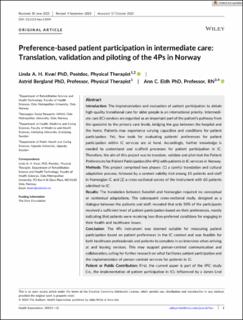| dc.description.abstract | Introduction: The implementation and evaluation of patient participation to obtain
high‐quality transitional care for older people is an international priority. Intermedi-
ate care (IC) services are regarded as an important part of the patient's pathway from
the specialist to the primary care levels, bridging the gap between the hospital and
the home. Patients may experience varying capacities and conditions for patient
participation. Yet, few tools for evaluating patients' preferences for patient
participation within IC services are at hand. Accordingly, further knowledge is
needed to understand and scaffold processes for patient participation in IC.
Therefore, the aim of this project was to translate, validate and pilot test the Patient
Preferences for Patient Participation (the 4Ps) with patients in IC services in Norway.
Methods: This project comprised two phases: (1) a careful translation and cultural
adaptation process, followed by a content validity trial among 15 patients and staff
in Norwegian IC and (2) a cross‐sectional survey of the instrument with 60 patients
admitted to IC.
Results: The translation between Swedish and Norwegian required no conceptual
or contextual adaptations. The subsequent cross‐sectional study, designed as a
dialogue between the patients and staff, revealed that only 50% of the participants
received a sufficient level of patient participation based on their preferences, mostly
indicating that patients were receiving less‐than‐preferred conditions for engaging in
their health and healthcare issues.
Conclusion: The 4Ps instrument was deemed suitable for measuring patient
participation based on patient preferences in the IC context and was feasible for
both healthcare professionals and patients to complete in an interview when arriving
at and leaving services. This may support person‐centred communication and
collaboration, calling for further research on what facilitates patient participation and
the implementation of person‐centred services for patients in IC.
Patient or Public Contribution: First, the current paper is part of the IPIC study
(i.e., the implementation of patient participation in IC). Influenced by a James Lind Alliance process, the study addresses research uncertainties identified by patients,
next of kin, staff and researchers in the cocreation process. Second, cognitive
interviewing was conducted with 15 representatives of the target population: seven
patients receiving IC services, one home‐dwelling previous IC patient (altogether
four women and four men, most of them 80 years or older) and seven healthcare
staff working in IC services. The interviews determined the relevance, comprehen-
siveness and clarity of the 4Ps. Finally, 60 patients admitted to IC took part in the
cross‐sectional study. | en_US |

